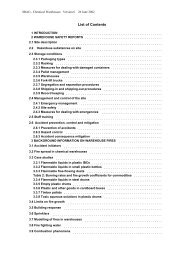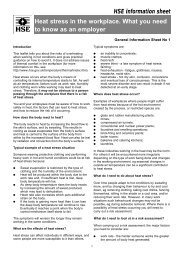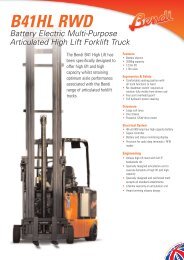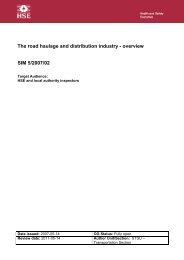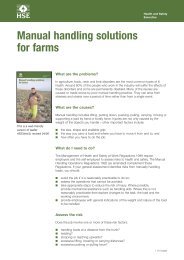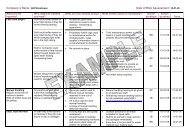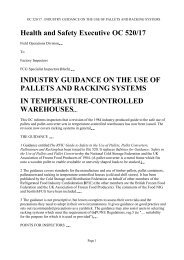Workplace transport inspection pack
Workplace transport inspection pack
Workplace transport inspection pack
Create successful ePaper yourself
Turn your PDF publications into a flip-book with our unique Google optimized e-Paper software.
4.2.3 Road haulageIn the 2004/05 workyear, there were 11 fatalities, 1487 major injuries and 6654 over-3 dayreports. The total accident rate in this industry is worse than both the construction andagriculture sectors. In addition, accident rates have worsened significantly over the past 3years.The Moving Goods Safely project is the main initiative aimed at tackling the high accidentrates within the haulage industry. Further information on MGS can be found in SIM 05/2006/03& SIM 05/2007/01. STSU Transportation Sector is also engaged with other industry work,including through the HSE-run safety forum, the Road Distribution Action Group (previouslyknown as the Road Haulage Liaison Group).A Sector Information Minute providing further background information on the road haulageindustry is now available (SIM 05/2007/02).Health and Safety legislation (apart from the <strong>Workplace</strong> Regulations) applies whilst the vehiclesis driving on the road as well as whilst it is involved in operations at the workplace. Howeverroad risk is largely dealt with by the Police, so inspectors should focus efforts on risks at theworkplace. You may draw attention to the Driving at Work document INDG382. OM2003/103and OM2003/109 give more details on work-related road risk.More information on road haulage can be found on the HSE website.Carriage of dangerous goods (CDG) issuesCarrying goods by road or rail involves the risk of traffic incidents. If the goods carried aredangerous, there is also the risk of an incident, such as spillage of the goods, leading tohazards such as fire, explosion, chemical burn or environmental damage.Whilst most goods are not considered sufficiently dangerous to require special precautionsduring carriage some do have properties which mean they are potentially dangerous if carried.There are regulations to deal with the carriage of dangerous goods, the purpose of which is toprotect everyone either directly involved (such as consignors or carriers), or who might becomeinvolved (such as members of the emergency services and public). Regulations place dutiesupon everyone involved in the carriage of dangerous goods, to ensure that they know what theyhave to do to minimise the risk of incidents and guarantee an effective response.Further details may be found at the following site:http://www.hse.gov.uk/cdg/index.htmReferencesINDG379 Health and safety in road haulageSIM 5/2001/16 Passenger Transport will be revised and updated in 2007SIM 5/2001/5 (SSP3) has been withdrawnSIM 05/2007/02 The road haulage and distribution industry – overviewSIM 05/2007/03 Car <strong>transport</strong>ersThe Carriage of Dangerous Goods Manual



